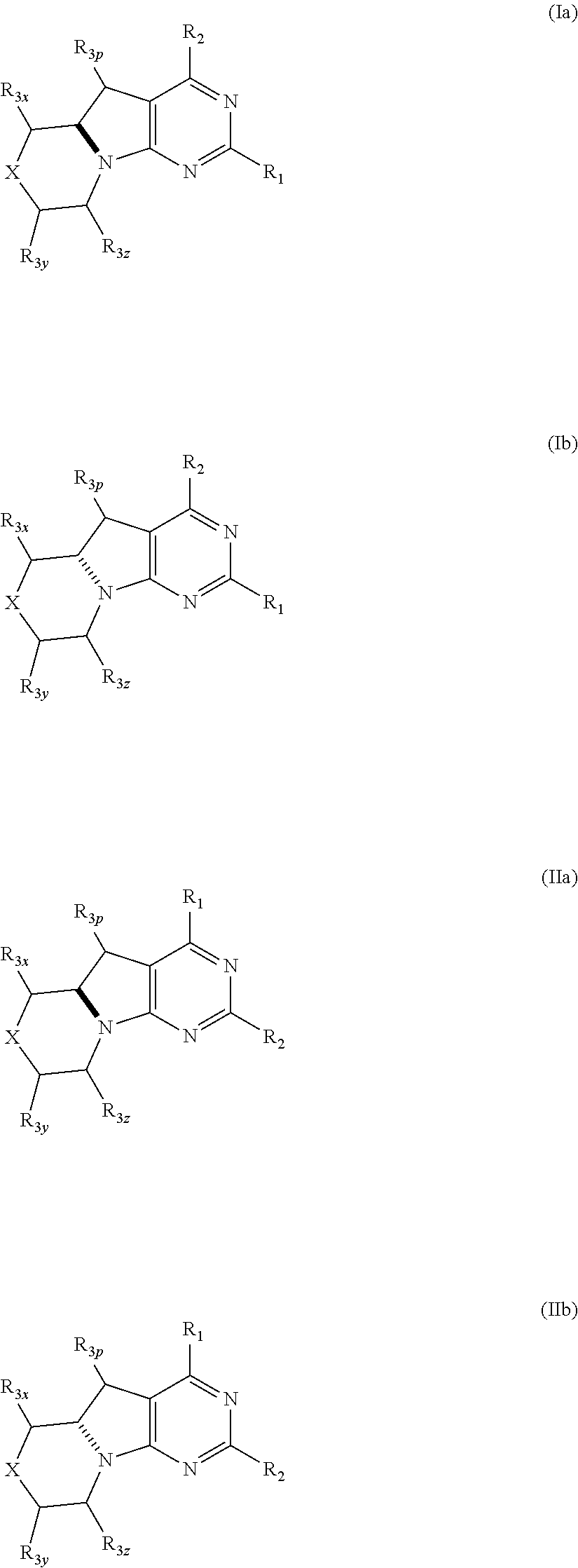Conformationally restricted p13k and mtor inhibitors
a p13k and mtor technology, applied in the field of new morpholinodihydropyrrolopyrimidines, can solve the problems of uncontrolled proliferation, enhanced migration and adhesion-dependent growth, and dilated cell death
- Summary
- Abstract
- Description
- Claims
- Application Information
AI Technical Summary
Benefits of technology
Problems solved by technology
Method used
Image
Examples
example 1
4-(4,6-Dichloropyrimidin-2-yl)morpholine and 4-(2,6-dichloropyrimidin-4-yl)morpholine
[0104]
[0105]A solution of morpholine (22.4 mL, 512.4 mmol, 4.2 eq) in EtOH (100 mL) is added dropwise to a cooled (0° C.) solution of 2,4,6-trichloropyrimidine (14 mL, 122 mmol, 1 eq) in EtOH (200 mL). The mixture is stirred at rt overnight. The crude mixture is poured onto a saturated solution of NaHSO4 (1 L), and the resulting precipitate is collected by filtration. The solid is redissolved in a minimal amount of DCM and adsorbed on silica gel. FC (AcOEt / Cycl 1:3→1:1) gives the desired compounds 4-(4,6-Dichloropyrimidin-2-yl)morpholine (20% yield) and 4-(2,6-dichloropyrimidin-4-yl)morpholine (65% yield).
4-(4,6-Dichloropyrimidin-2-yl)morpholine
[0106]1H NMR (400 MHz, CDCl3): δ 6.53 (s, 1H), 3.77 (m, 4H), 3.71 (m, 4H). 13C NMR (100.6 MHz, CDCl3): δ 161.6, 160.4, 108.2, 66.5, 44.3.
4-(2,6-dichloropyrimidin-4-yl)morpholine
[0107]1H NMR (400 MHz, CDCl3): δ 6.34 (s, 1H), 3.70 (m, 4H), 3.58 (m, 4H). 13C NMR...
example 2
(R)-Tetrahydro-3H-[1,2,3]oxathiazolo[4,3-c][1,4]oxazine 1,1-dioxide
[0108]
[0109]A solution of SOCl2 (0.82 mL, 11.3 mmol) in DCM (0.8 mL) is added dropwise to a cooled (−5° C.) solution of imidazole (2.38 g, 34.9 mmol) in DCM (15 mL), and the temperature kept at −5° C. The cooling bath is removed and the reaction mixture is stirred over 45 min while allowing it to warm up to rt. The mixture is cooled down to −10° C. A solution of (S)-morpholin-3-ylmethanol (0.68 g, 5.8 mmol) in DCM (5.8 mL) is added dropwise while keeping the temperature around −10° C. The mixture is stirred at −5° C. for 2 h, and then at +5° C. for 1 h. Water (15 mL) is added and the layers are separated. The organic layer is washed with half concentrated brine (15 mL), and cooled to 0° C. A solution of NalO4 (3.73 g, 17.4 mmol) in water (40 mL) is added, followed by Ru2O—H2O (8 mg). The bath is removed after 15 min and the dark reaction mixture stirred overnight. The layers are separated and the organic layer is fil...
example 3
(S)-2-Chloro-4-morpholino-5a,6,8,9-tetrahydro-5H-pyrimido[5′,4′:4,5]pyrrolo[2,1-c][1,4]oxazine
[0114]
[0115]A 1.6 M n-BuLi solution (1.4 mL) is cooled down to −78° C., and a solution of 4-(2,6-dichloropyrimidin-4-yl)morpholine (435 mg, 1.86 mmol) in THF (5 mL) is added dropwise. The mixture is stirred at −78° C. for 35 min. Cul (14 mg, 0.07 mmol) and a solution of (R)-tetrahydro-3H-[1,2,3]oxathiazolo[4,3-c][1,4]oxazine 1,1-dioxide (333 mg, 1.86 mmol) in THF (3 mL) is added. The mixture is stirred at −78° C. and then allowed to warm to rt, then stirred for 16 h. The reaction is quenched by addition of water (1 mL). 15% HCl (10 mL) and methanol (5 mL) are added, and the mixture heated to 60° C. for 5 h. The organic solvents are removed by rotary evaporation and the remaining aqueous layer diluted with 2 M NaOH (5 mL). NaOH pellets are used to adjust the pH to 11. AcOEt (10 mL) is added and the mixture stirred for 30 minutes. The layers are separated and the aqueous layer extracted with ...
PUM
| Property | Measurement | Unit |
|---|---|---|
| temperature | aaaaa | aaaaa |
| temperature | aaaaa | aaaaa |
| temperature | aaaaa | aaaaa |
Abstract
Description
Claims
Application Information
 Login to View More
Login to View More - R&D
- Intellectual Property
- Life Sciences
- Materials
- Tech Scout
- Unparalleled Data Quality
- Higher Quality Content
- 60% Fewer Hallucinations
Browse by: Latest US Patents, China's latest patents, Technical Efficacy Thesaurus, Application Domain, Technology Topic, Popular Technical Reports.
© 2025 PatSnap. All rights reserved.Legal|Privacy policy|Modern Slavery Act Transparency Statement|Sitemap|About US| Contact US: help@patsnap.com



